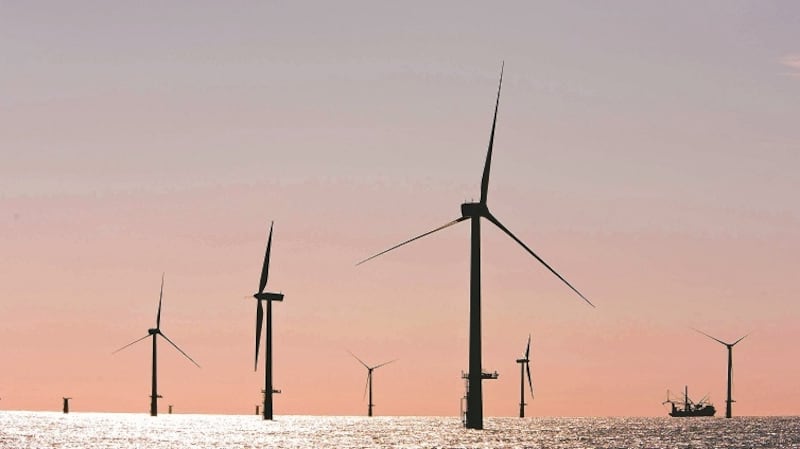On Monday, as he was leaving for Ostend in Belgium to attend an international summit on the development of offshore wind energy in Europe’s northern seas, the Taoiseach used the words “pressing” and “urgency”. The first was in relation to climate change; the second referred to the “urgency of action… reinforced by Russia’s brutal invasion of Ukraine”.
He also referred to offshore energy development as “our 21st-century moonshot”. Ground control to Major Leo: your circuit’s dead; there’s something wrong.
Leo Varadkar’s evocation of a sense of urgency prompted me to wonder when the issue of offshore wind farming first presented itself to the Irish political system. I can tell you now: it was almost a quarter of a century ago.
It was in 1999 that an all-island group, commissioned by the governments of the Republic and Northern Ireland, created an atlas of the vast offshore wind energy resource in our waters. That same year, the first application for a commercial licence to survey and build an offshore farm was lodged with the Department of the Marine.
READ MORE
It was also at that time that Eddie O’Connor, the founder of Airtricity (one of Ireland’s earliest wind developers and private energy suppliers), began to push for Ireland to become a world leader in “ending the carbon economy era” by exporting its abundant offshore wind resource to the rest of the EU.
All of this highlighted a certain embarrassment: the legislation governing this area dated back to 1933. It was obvious that the most basic job of the government and the Oireachtas was to put in place a contemporary regime of regulation for offshore energy.
And here we are, 24 years on, and such a regime is still not fully operating. If you want a case study of what the State means by “urgent”, try this slow-mo movie. It will remind you that Einstein wasn’t kidding when he said that time is a relative concept.
What happened after the issue of offshore wind inserted itself into the Irish political and governmental systems in 1999 is pretty much nothing. In 2002, Mary O’Rourke, who was then the relevant minister, announced that she would be concentrating on onshore wind farms and effectively dismissed the relevance of their offshore counterparts.
Five years later, the then government issued Ireland’s first White Paper on energy policy. It said essentially nothing about offshore wind.
How do we explain this indifference? Is the opportunity simply too big for small-minded politics to grasp? Is the Atlantic too vast to flow through the parish pump?
Is it because Ireland is in a weird state of denial about its status as an island with a maritime territory seven times its landmass? Is it because the time taken to lay the groundwork for offshore energy did not fall neatly within the electoral cycle – there would be no votes in it for now?
By 2016, the government’s legislative programme had it marked as ‘may resubmit for further consideration’ – political speak for ‘do not resuscitate’
For whatever combination of these reasons, the whole question was essentially ignored by the State until the Green Party went into government with Fianna Fáil in 2007. In the joint programme for government, it secured a weakly worded commitment to “examining the possibility of appropriate support measures for offshore wind”.
One thing that was definitely going to be done, though, was to create, at last, a functioning regime for licensing and regulating offshore wind. So confident was the State that this was about to happen that it put in place a moratorium on new offshore projects pending the imminent arrival of its new regime.

And then came the banking crash. The Greens pulled out of government. All policy innovation was sidelined. Civil servants working on this area were moved or made redundant.
However, 10 years ago in 2013, the Fine Gael-Labour government finally approved the heads of the Maritime Area and Foreshore (Amendment) Bill, which was going to update and streamline the legislation relevant to offshore development.
It had taken a mere 14 years to get to this stage. But now at least something serious was happening.
By February 2014, the Bill had gone through pre-legislative parliamentary scrutiny. And then the attorney general pointed out that parts of it were so poorly drafted that it might well be unconstitutional.
The whole thing simply withered and died. No one tried to fix the Bill. By 2016, the government’s legislative programme had it marked as “may resubmit for further consideration” – political speak for “do not resuscitate”.
What this has meant is that companies with plans to develop offshore resources had to put them in abeyance because they did not know what regulatory regime they were supposed to operate under. And companies that might be interested were put off by this lack of legal certainty.
Legislation was finally passed by the Oireachtas and signed by the President at the end of 2021. But to come into effect, it needs the proposed Maritime Area Regulatory Authority to be up and running. Its website currently says that it is “Coming Soon”.
If this is our moonshot, the entire political system obviously needs a rocket under it. This saga is marked by indifference, incompetence, neglect and a lack of vision and political leadership.
And all of this, remember, is the easy bit. It is just the legal and bureaucratic apparatus – the physical stuff is a whole other story.
Where we should be world-class, we’ve ended up at the back of the class
As things stand, the port most likely to benefit from the eventual development of Ireland’s offshore wind resources is Liverpool. Why? Because the State has failed to develop a single port capable of servicing the industry.
What will happen when we finally get around to deciding to build one? Most probably a prolonged standoff between different port cities and towns and their political champions. Making decisions will offend various constituencies – one reason why no one has got around to doing it yet.
This is how Ireland went from being a potential leader in this field to being a laggard. Where we should be world-class, we’ve ended up at the back of the class.
[ Fintan O’Toole: The EU has a vast untapped energy resource – IrelandOpens in new window ]
The political system really needs to ask itself why other countries can respond to challenges and opportunities with reasonable speed while Ireland can’t. Why is it so deeply embroiled in crisis management that even a 10-year time-frame is too long to contemplate?
We have a system in which everything is either a crisis or it is nothing. Issues that are not screaming out from the daily headlines are allowed to drift on the tide.
In the story of Irish offshore wind energy, that system should see itself as it must appear to other countries that have leaped so far ahead of us: too much wind, not enough energy.














